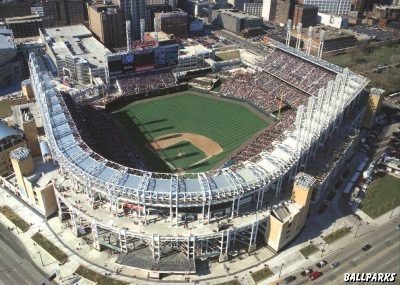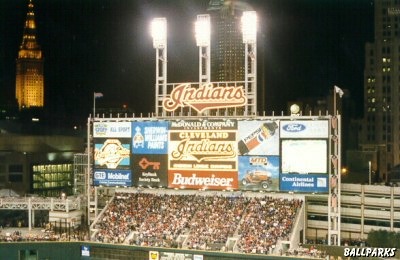Progressive Field
formerly Jacobs Field Cleveland, OhioTenant: Cleveland Indians (AL) Architect: HOK Sport (Kansas City) Cleveland Indians tickets:
Location: Left field (NW), East Huron Road; third base (SW), Broadway/Ontario Street; first base (SE), Carnegie Avenue; right field (NE), East 9th Street. Dimensions: Left field: 325 ft.; left-center: 370 ft.;center field: 405 ft.; right-center: 375 ft.; right field: 325 ft.; foul territory: small. Fences: Left field: 19 ft.; center and right fields: 8 ft.
For years, baseball in Cleveland was played in the cold, cramped, mammoth Cleveland Municipal Stadium. "The Mistake by the Lake," as they called it, had been the home of Cleveland baseball since it first opened in 1932, although the Indians still played some games at old League Park until 1947. Its center-field bleachers, known as "the Dawg Pound" during the NFL Cleveland Browns games, were so distant that no batter ever reached them with a home run. Cleveland Municipal Stadium had more than 74,000 seats (more than any other major league park) but few of those seats were filled when the Indians played. That all changed when Progressive Field, which has only 43,345 seats, opened in 1994. Attendance suddenly boomed. In their first year at the new park, Cleveland averaged 39,121 fans per game. The final 28 games before a season-ending strike all sold out. Cleveland Stadium had lots of seats, few luxury boxes, and cramped clubhouses. Progressive Field is smaller, with many luxury boxes and large clubhouses. Cleveland Municipal Stadium was next to Lake Erie, but Progressive Field is conveniently located in the middle of downtown. Cleveland Municipal Stadium, which was built for a failed attempt by Cleveland to host the 1932 Olympics, functioned more as a football stadium than a baseball park. Progressive Field, by contrast, was built only for baseball. Despite its modern luxuries, Progressive Field has some of the features of classic ballparks. The field is asymmetrical, and bleachers sit atop a 19-foot left-field wall. Because the park isnít completely enclosed, fans can look out over the buildings of downtown Cleveland.
Progressive Field is similar in look and feel to Baltimore's Camden Yards, opened two years earlier. But the Indians did some things with their ballpark that the Orioles didn't. The seats down both lines are angled towards home plate so that fans don't need to turn their heads to watch the game. An area behind first base is designated Kidsland, with special concessions and features. Then there are the bullpens, which feature three mounds. As in Baltimore, the bullpens are raised above the playing field so that fans can see who is warming up. A picnic area is located behind the outfield fence, just as in Baltimore. The ballpark was built with a combination of public and private support, including a 15-year Cuyahoga County sin tax, tax-exempt Gateway Bonds, and prepaid leasing on the luxury boxes. The name of the park was sold to Richard E. Jacobs, the Indians owner at the time, for $10 million and expired in 2006. The tax on cigarettes and alcohol expired as scheduled in 2005, only to start up again the next day. That is because, in 1995, Cuyahoga County voters authorized a ten year extension of the tax to help fund a new stadium for the Cleveland Browns NFL team. On January 11, 2008, after a two year search for a new naming rights partner, it was announced that the Indians had signed a pact with Progressive Corporation. The insurance company agreed to pay the Indians approximately $3.6 million per year for 16 years, which coincides with the time remaining on the team's lease.
Progressive Field Trivia:
More on Progressive Field: Recommended Reading (bibliography):
Cleveland Indians Help us provide a better web site by completing our feedback form PHOTOGRAPHS: Aerial view of Progressive Field © 1994 by Mike Smith Updated January 2008 Tickets to Cleveland Indians, Indians White Sox, Indians Yankees, NCAA Basketball Tournament, College Football Bowl, NCAA Football, Cleveland Browns and Paul McCartney provided by Ticket Triangle. BALLPARKS © 1996-2014 by Munsey & Suppes.
|







